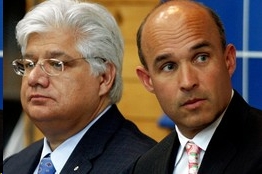WSJ: 28/6/2012 Multiple Missteps Led to RIM's Fall..the CEO problem
WATERLOO, Ontario—As the BlackBerry smartphone fell steadily further behind
app-loaded rivals like the iPhone in recent years, it was time for an
unambiguous response from the chief executive’s office.
At Research In Motion Ltd., however, that was complicated. The BlackBerry
maker had two chief executives. Moreover, their offices were about a
10-minute drive apart. Meetings with both of them present were rare, say
former RIM executives and people who dealt with the company.
Many forces have combined to bring RIM to the point of reporting a
quarterly operating loss, as is expected on Thursday, but one of them was a
split personality in the executive suite, former executives say. As
investor pressure mounted at the company recently, one CEO, company founder
Mike Lazaridis, was focused on a make-or-break push to launch a
next-generation BlackBerry with a new operating system. His co-CEO, Jim
Balsillie, started pursuing a separate strategy that envisioned licensing
out some of the company’s proprietary technologies.
Both men are gone from the CEO suite now, replaced in January by former
Lazaridis lieutenant Thorsten Heins. He is slashing costs. RIM says it is
committed to seeing through the rollout later this year of its next
BlackBerry. But Mr. Heins has hired investment bankers to explore options
and hasn’t ruled out a sale of a company, whose stock has tanked nearly 70%
in 12 months and pushed its market value, at under $5 billion, to less than
one-fifteenth of its peak.
RIM still has a comfortable cash cushion of more than $2 billion, which it
said last month is likely to have grown in its fiscal first quarter ended
June 2. It also is debt-free, giving it more breathing room to get out its
new phone, with an operating system called BlackBerry 10 that RIM says
“sets the standard for reliable, secure mobile computing.” RIM has told its
bankers it is focused on that rollout, said a person familiar with the
matter. If the phone is a hit, the company will recover some of its lost
value, and the new technology will be a boon to any possible sale or
partnership in the future, this person said.
According to interviews with more than a dozen former RIM executives and
industry executives who worked closely with the company, it was a blinding
confidence in the basic BlackBerry product that was at the root of RIM’s
current troubles. Compounding that, as they describe the events, were a
drawn-out internal debate over who their core customer was; a series of
catch-up products that didn’t really catch the company up; and tensions
within parts of the company.
The bet long made by RIM was that both corporate and individual customers
would continue to favor the BlackBerry’s easy-to-use mobile email over the
multiplying features and apps on Apple Inc.’s iPhone and devices running on
Google Inc.’s Android operating system. When it saw consumers starting to
gravitate away from BlackBerrys, RIM moved tentatively.
At one point, RIM worked to challenge the iPhone with telecom carriers that
were fearful of Apple’s dominance. The new models that came out of these
collaborations, however, failed to generate iPhone-like buzz.
RIM isn’t alone in failing to adapt quickly to the transformation of
smartphones from devices to talk and email into pocket-size computers.
Once-dominant Nokia Corp. has been forced into a partnership with Microsoft
Corp. to equip its phones to compete, and is slashing thousands of jobs as
its share of the global smartphone market erodes.
[image: Emacs!]
At RIM, executives eventually brought in outside talent, but that raised
tensions inside the ranks of a company that already harbored separate
Lazaridis and Balsillie fiefs, some former RIM executives and executives
who have worked with RIM say. According to them, the separate teams
sometimes clashed, especially as the onetime smartphone leader slipped
further behind.
RIM, in a statement, said the split-personality characterization wasn’t
accurate. “As with any innovative company there were times when various
people within the organization disagreed, but this was not the norm,” it
said.
“The CEO structure worked well for many years and allowed each of the
co-CEOs to focus on their areas of strength,” RIM added. It said the
co-CEOs started out sharing an office, had offices next to each other, and
then, “as RIM grew, they each took offices closest to those areas each
supervised in order to stay close to their teams. At all times, they had an
efficient, professional working relationship and were in close
communication.”
Mr. Heins, soon after taking over as CEO early this year, put an end to the
strategy pursued by one CEO: Mr. Balsillie’s licensing initiative. RIM said
it doesn’t discuss nonpublic internal deliberations.
Mr. Balsillie has given up his board seat. Mr. Lazaridis remains
nonexecutive vice chairman.
“Successful companies take what they can learn from every situation and use
that to push forward,” Mr. Lazaridis said, noting that he and Mr. Balsillie
“felt it was the right time in RIM’s life cycle to turn the leadership of
the company over to someone else.” Mr. Balsillie didn’t respond to requests
for comment.
RIM didn’t make Mr. Heins available, citing a quiet period before the
earnings release.
*RIM essentially invented email on the go. Founded by Mr. Lazaridis in 1984
with a $15,000 loan from his parents, the company grew to a stock-market
value of more than $80 billion at its zenith in 2008, controlling about
half the U.S. smartphone market.
* [image: Emacs!]
RIM CEO Thorsten Heins
RIM hosted lavish banquets for its inventors. To mark milestones, it
treated employees to concerts by bands such as U2 and Van Halen. At the
company’s campus of low-slung gray buildings 70 miles from Toronto,
employees got free ice cream on “Frosty Fridays.”
Amid its cost-cutting, RIM isn’t giving up entirely on ice cream days. “Ice
cream is a relatively low-cost way to build stronger bonds within our
team,” RIM said.
Mr. Balsillie, who came aboard in 1992 after having explored a takeover bid
for the company, and Mr. Lazaridis became Canada’s best-known billionaires,
each funneling chunks of wealth to pet projects. Mr. Lazaridis built a
theoretical-physics institute. Mr. Balsillie started a school for global
governance and tried unsuccessfully to buy three professional hockey teams.
Behind the success was Mr. Lazaridis’s unrelenting vision for robust
engineering and innovation and Mr. Balsillie’s push for market expansion.
But former executives say there was also an aversion at the company to
innovations that didn’t buttress its core strengths: its proprietary
network and reputation for security.
At an investor meeting about a decade ago, analysts asked Mr. Lazaridis
whether RIM was moving to a color screen, a feature popping up on devices
in Asia. “Do I need to read my email in color?” he replied, according to
Brian Blair, then an analyst with Banc of America Securities.
[image: Emacs!]
Former co-CEOs Mike Lazaridis and Jim Balsillie in January
RIM says that at the time, color screens were impractical, with high costs
and high battery drain. It says it was among the first to adopt color
displays just a few years later.
RIM’s customers then were overwhelmingly companies, which gave their
employees BlackBerrys for email. But a growing number were individuals,
often eager for features such as cameras, games and Internet browsing. RIM
brought out device
s with cameras and MP3 players including the Pearl in
2006 and the Curve in 2007—the year the iPhone came out.
Still, RIM’s carrier partners worried that the wild popularity of the
iPhone could give Apple outsize influence in the market. Executives at
Verizon Communications Inc. and Vodafone Group PLC approached RIM to work
together on a phone that could compete with the iPhone, say people familiar
with the matter. The collaboration resulted in RIM’s first touch-screen
device, the Storm.
“Vodafone started really rushing around saying, ‘Helps us build an
innovative competitor to the iPhone,’ ” said Pieter Knook, a Vodafone
executive at the time. He said Mr. Lazaridis came up with the Storm’s
marquee innovation, a touch screen that physically clicked.
The Storm “sold very well,” but wasn’t a strong competitor to the iPhone,
said Denny Strigl, at the time president of Verizon.
In 2010, AT&T Inc., then Apple’s exclusive carrier partner, approached RIM
about a plan to develop a touch-screen rival to the iPhone, said two former
RIM executives. The chief of AT&T’s mobile division visited RIM’s research
and development team in Waterloo to stress how important it was for AT&T to
have a successful BlackBerry product to sell, according to people familiar
with the visit. RIM said the objective of the visit was to develop “a
differentiated, unique BlackBerry experience for AT&T customers.”
“We work with all device makers to bring the best products to market for
our customers,” AT&T said.
A RIM-AT&T collaboration resulted in the BlackBerry Torch, say people
familiar with the effort, but it was hobbled by hardware and software
shortcomings.
RIM executives also missed some internal warnings. The sales division
produced a research report in 2010 on the future of tactile keyboards, the
thumb-friendly feature that was a favorite in the early days of the
BlackBerry. The report warned that in the era of Apple’s touch-only
devices, keyboards would make up a diminishing share of the market,
according to a person familiar with it, who said the warning was ignored.
During a meeting the same year, Mr. Balsillie asked if RIM should be
worried about a new trend: consumers bringing their own smartphones to work
and asking their employer to let them work on the devices. Some executives
said the trend was a threat; a few said they weren’t worried. Mr. Balsillie
went with the latter view, said a person close to the company. RIM said it
doesn’t discuss nonpublic “internal company deliberations.”
As Apple and Android devices ate into BlackBerry’s market share, Mr.
Lazaridis started looking outside for innovation, bringing in a new
marketing team and other top executives. In April 2010 RIM bought QNX
Software Systems, a maker of operating systems for cars and medical
devices. RIM was readying a tablet to compete with the iPad, and executives
decided that they would use QNX to power the device, called the PlayBook.
According to people close to the company, the acquisition stoked tensions
between the teams led by Mr. Lazaridis, who was in charge of product
development, manufacturing and R&D, and Mr. Balsillie, who ran carrier
partnerships, sales and marketing.
[image: Emacs!]
The two CEOs met in person fairly regularly, and would send instant
messages or call each other to bounce ideas around or get progress reports
when they weren’t in the same room. But as RIM hit trouble, they were more
often than not toiling in very different worlds, according to these people,
who say the teams reporting up to the two didn’t communicate effectively if
at all. Some projects would go astray before either co-CEO noticed, these
people say, and disagreements between the two sides sometimes devolved into
shouting matches.
The QNX leadership team reported directly to Mr. Lazaridis, bypassing Mr.
Balsillie and other top RIM officers, rankling them, according to people
familiar with the situation.
Meanwhile, by late 2011, Mr. Balsillie was deep into his own project, an
effort aimed at licensing some of RIM’s proprietary technology, such as its
security network and its popular BBM messaging tool, to outside companies.
Some analysts had long suggested such a move to boost revenue and buy the
company more time as it readied its new phone.
Mr. Balsillie and a team under him struck licensing agreements with several
partners, including carriers, according to people familiar with the effort.
The deals would have allowed other smartphone makers and the carriers to
use RIM’s network for a fee.
But by the end of last year, RIM shares were hitting eight-year lows. On
Jan. 22, the board, led by Messrs. Lazaridis and Balsillie as co-chairmen,
said the two would step aside. They remained big shareholders and each kept
a board seat.
Within a week of becoming CEO, Mr. Heins, a Lazaridis lieutenant, scuttled
the licensing plan, people familiar with it said. He said he would focus a
slimmed-down RIM on rolling out its new BlackBerry phone

– Posted using MobyPicture.com





